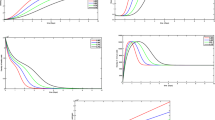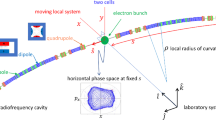Abstract
Experimental work and theoretical models deduce a “digital” response of the p53 transcription factor when genomic integrity is damaged. The mutual influence of p53 and its antagonist, the Mdm2 oncogene, is closed in a feedback. This paper proposes an aerospace-based architecture for translating the p53/Mdm2/DNA damage network into a digital circuitry in which the optimal control theory is applied for obtaining the requested dynamic evolutions of some considered cell species for repairing a DNA damage. The purpose of this paper is to demonstrate the usefulness of such digital circuitry design to detect and predict the cell species dynamics for shedding light on their inner and mutual mechanisms of interaction. Moreover, the cell fate is newly conceived by the modified pulsing mechanism of p53 and other apoptotic species when the digital optimal control is applied to an apoptosis wiring diagram.
Similar content being viewed by others
References
Ambrosi D., Preziosi L., On the closure of mass balance models for tumour growth, Math. Mod. Meth. Appl., 2002, 12, 737–754
Ambrosi D., Mollica F., On the mechanics of a growing tumour, Int. J. Eng. Sci., 2002, 40, 1297–1316
Ambrosi D., Mollica F., The role of stress in the growth of a multicell spheroid, J. Math. Biol., 2004, 48, 477–499
Breward C.J.W., Byrne H.M., Lewis C.E., The role of cell-cell interaction in a two-phase model for a vascular tumour growth, J. Math. Biol., 2002, 45, 125–152
Byrne H.M., King J.R., McElwain D.L.S., Preziosi L., A two-phase model of solid tumour growth, Appl. Math. Lett., 2003, 16, 567–573
Byrne H.M., Preziosi L., Modeling solid tumours growth using the theory of mixtures, Math. Med. Biol., 2004, 20, 341–366
Chaplain M., Graziano L., Preziosi L., Mathematical modelling of the loss of tissue compression responsiveness and its role in solid tumour development, Math. Med. Biol., 2006, 23, 197–229
Frieboes H., Zheng X., Sun C.H., Tromberg B., Gatenby R., Cristini V., An integrated computational/experimental model of tumour invasion, Cancer Res., 2006, 66, 1597–1604
Macklin P., Lowengrub J., Nonlinear simulation of the effect of the microenvironment on tumour growth, J. Theor. Biol., 2007, 245, 677–704
Panorchan P., Thompson M.S., Davis K.J., Tseng Y., Konstantopoulos K., Wirtz D., Single-molecule analysis of cadherin-mediated cell-cell adhesion, J. Cell Sci., 2006, 119, 66–74
Ma L., Wagner J., Rice J.J., Hu W., Levine A., Slolovitzky G.A., A plausible model for the digital response of p53 to DNA damage, Proc. Natl. Acad. Sci. USA, 2005, 40, 14266–14271
Geva-Zatorsky N., Rosenfeld N., Itzkovitz S., Milo R., Sigal A., Dekel E., et al., Oscillations and variability in the p53 system, Mol. Syst. Biol., 2006, 2, 1–13
Shangary S., Wang S., Targeting the Mdm2-p53 interaction for cancer therapy, Clin. Cancer Res., 2008, 17, 5318–5324
Ciliberto A, Novak B, Tyson J, Steady states and oscillations in the p53/Mdm2 network, Cell Cycle, 2005, 3, 488–493
Zhang T., Brazhnik P., Tyson J.J., Exploring mechanisms of the DNA-damage response, Cell Cycle, 2007, 1, 85–94
Reich C.N., Oren M., Levine A.J., Two distinct mechanisms regulate the levels of a cellular tumor antigen, p53, Mol. Cell Biol., 1983, 12, 2143–2150
Ventura A., Kirsch D.G., McLaughlin M.E., David A., Tuveson D.A., Grimm J., et al., Restoration of p53 function leads to tumour regression in vivo, Nature, 2007, 445, 661–665
Bates S., Phillips A.C., Clark P.A., Stott F., Peters G., Ludwig R.L., p14ARF links the tumour suppressor RB and p53, Nature, 1998, 395, 124–125
Harms K.L., Chen X., The C terminus of p53 family proteins is a cell fate determinant, Mol. Cell Biol., 2005, 5, 2014–2030
Bell S., Klein C., Muller L., Hansen S., Buchner J., p53 contains large unstructured regions in its native state, J. Mol. Biol., 2002, 322, 917–927
Bar-Or R.L., Maya R., Segel L.A., Alon U, Levine AJ, Oren M., Generation of oscillations by the p53-Mdm2 feedback loop: a theorethical and experimental study, Proc. Natl. Acad. Sci. USA, 2000, 21, 11250–11255
Lahav G., Rosenfeld N., Sigal A., Geva-Zatorsky N., Levine A.J., Elowitz M.B., et al., Dynamics of the p53-Mdm2 feedback loop in individual cells, Nat. Genet., 2004, 36, 147–150
Loewer A., Lahav G., Cellular conference call: external feedback affect cell-fate decision, Cell, 2006, 124, 1128–1130
Batchelor E., Mock C.S., Bhan I., Loewer A., Lahav G., Recurrent initiation: a mechanism for triggering p53 pulses in response to DNA damage, Mol. Cell, 2008, 30, 277–289
Ardito Marretta R.M., Marino F., Wing flutter suppression enhancement using a well-suited active control model, J. Aero Eng., 2007, 221, 441–453
Ardito Marretta R.M., Marino F., Bianchi P., Computer active control of damping fluid of a racing superbike suspension scheme for road-safety improvement spin-off, Int. J. Vehicle Des., 2008, 46, 436–450
Author information
Authors and Affiliations
Corresponding author
About this article
Cite this article
Ardito Marretta, R.M. Digital control circuitry for the p53 dynamics in cancer cell and apoptosis. cent.eur.j.biol. 5, 197–213 (2010). https://doi.org/10.2478/s11535-009-0068-3
Received:
Accepted:
Published:
Issue Date:
DOI: https://doi.org/10.2478/s11535-009-0068-3




